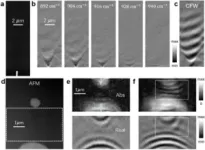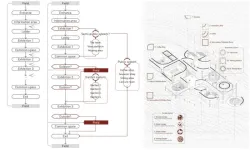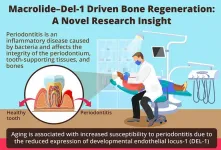(Press-News.org) A collaborative research team co-led by Professor Shuang ZHANG, the Interim Head of the Department of Physics, The University of Hong Kong (HKU), along with Professor Qing DAI from National Center for Nanoscience and Technology, China, has introduced a solution to a prevalent issue in the realm of nanophotonics – the study of light at an extremely small scale. Their findings, recently published in the prestigious academic journal Nature Materials, propose a synthetic complex frequency wave (CFW) approach to address optical loss in polariton propagation. These findings offer practical solutions such as more efficient light-based devices for faster and more compact data storage and processing in devices such as computer chips and data storage devices, and improved accuracy in sensors, imaging techniques, and security systems.
Surface plasmon polaritons and phonon polaritons offer advantages such as efficient energy storage, local field enhancement, and high sensitivities, benefitting from their ability to confine light at small scales. However, their practical applications are hindered by the issue of ohmic loss, which causes energy dissipation when interacting with natural materials.
Over the past three decades, this limitation has impeded progress in nanophotonics for sensing, superimaging, and nanophotonic circuits. Overcoming ohmic loss would significantly enhance device performance, enabling advancement in sensing technology, high-resolution imaging, and advanced nanophotonic circuits.
Professor Shuang Zhang, corresponding author of the paper, explained the research focus, ‘To address the optical loss challenge in key applications, we have put forward a practical solution. By employing a novel synthetic complex wave excitation, we can achieve virtual gain and counteract the intrinsic loss of the polariton system. To validate this approach, we applied it to the phonon polariton propagation system and observed a significant improvement in polariton propagation.’
‘We demonstrated our approach by conducting experiments using phonon polariton material, such as hBN and MoO3, in the optical frequency range. As expected, we obtained nearly lossless propagation distance consistent with our theoretical predictions,’ added Dr Fuxin GUAN, the paper’s first author and a Postdoctoral Fellow at the Department of Physics at HKU.
Multi-frequency approach to overcome optical loss
In this research, the team developed a novel multiple-frequency approach to address energy loss in polariton propagation. They used a special type of wave called ‘complex frequency waves’ to achieve virtual gain and compensate for the loss in an optical system. While a regular wave maintains a constant amplitude or intensity over time, a complex frequency wave exhibits both oscillation and amplification simultaneously. This characteristic allows for a more comprehensive representation of wave behaviour and enables compensation for energy loss.
While frequency is commonly perceived as a real number, it can also have an imaginary part. This imaginary part tells us how the wave either gets stronger or weaker over time. Waves with a complex frequency featuring a negative (positive) imaginary part decay (amplify) over time. However, directly carrying our measurement under the excitation of complex frequency waves in optics is challenging because it requires complex time-gated measurements. To overcome this, the researchers employed the Fourier Transformation mathematical tool to break down a truncated complex frequency wave (CFW) into multiple components with individual frequencies.
Just like when you are cooking and need a specific ingredient that is hard to find, the researchers used a similar idea. They broke down the complex frequency waves into simpler components, like using substitute ingredients in a recipe. Each component represented a different aspect of the wave. It is like creating a delicious dish by using substitute ingredients to get the desired flavour. By measuring these components at different frequencies and combining the data, they reconstructed the behaviour of the system illuminated by the complex frequency wave. This helped them understand and compensate for the energy loss. This approach greatly simplifies the practical implementation of CFWs in different applications, including polariton propagation and superimaging. By conducting optical measurements at different real frequencies with a fixed interval, it becomes feasible to construct the optical response of the system at a complex frequency. This is achieved by mathematically combining the optical responses obtained at different real frequencies.
Professor Qing DAI, the National Center for Nanoscience and Technology and another corresponding author of the paper, stated that this work has provided a practical solution to address the long-standing issue of optical loss in nanophotonics. He highlighted the significance of the synthesised complex-frequency method, stating that it can be easily applied to various other applications like molecular sensing and nanophotonic integrated circuits. He further emphasised that ‘this method is remarkable and universally applicable, as it can also be utilised to address loss in other wave systems, including sound waves, elastic waves, and quantum waves, thereby enhancing the quality of imaging to unprecedented levels.’
This work was supported by the New Cornerstone Science Foundation, the Research Grants Council of Hong Kong.
The journal paper can be accessed at the following link: ‘Compensating losses in polariton propagation with synthesized complex frequency excitation’, Nature Materials. https://www.nature.com/articles/s41563-023-01787-8
More information about Professor Shuang Zhang: https://shorturl.at/efCN1
For media enquiries, please contact Ms Casey To, External Relations Officer (tel: 3917 4948; email: caseyto@hku.hk / Ms Cindy Chan, Assistant Director of Communications of HKU, Faculty of Science (tel: 39175286; email: cindycst@hku.hk).
Images download and captions: https://www.scifac.hku.hk/press
Supplementary Note: Experimental Demonstration
As a proof of concept, the team started with phonon polaritons (PhPs) propagation at optical frequencies about 1450 cm-1 using hBN films. A long gold antenna placed on the hBN film is used to launch the 1D PhPs. The field distributions of the two real frequencies and the two complex frequencies are displayed in Fig. 2a and 2b, respectively. The experimental results demonstrate that while the propagation at the real frequencies suffers strong attenuation, the polariton at the complex frequencies experiences almost no decay along the propagation.
The team further applied the complex frequency approach to investigate the more complicated field distributions supported by a thin film of van der Waals crystal α-MoO3, which is highly anisotropic and supports natural in-plane hyperbolic polaritons. A metal antenna as an excitation source is placed on the α-MoO3 film as shown in Fig. 3a. The field distribution variation exhibits a characteristic hyperbolic propagation behaviour with a concave wavefront see Fig. 3b. With the increase of the frequency, the wavelength decreases with a stronger field confinement, and meanwhile, the propagation becomes more attenuated. All of these real frequency plots are combined according to the ratio of complex frequency to obtain the complex frequency result in Fig. 3c.
The team finally investigated the interference behavior of PhPs using the complex frequency approach. Two circular antennas with different diameters are fabricated on the MoO3 film to excite the phonon polaritons, as shown in Fig. 3d. While the real frequency plots cannot show clear interference fringes, as shown in Fig. 3e, the complex frequency plots of clear interference fringes can be synthesised after combining the results of different real frequencies and as shown in Fig. 3f.
END
Recovering lossless propagation: HKU physicists overcoming optical loss in polariton system with synthetic complex frequency waves
2024-01-25
ELSE PRESS RELEASES FROM THIS DATE:
HKU Common Core and HKUMed teams win one Silver and one Bronze in QS Reimagine Education Awards
2024-01-25
Two innovative teaching and learning projects led by The University of Hong Kong (HKU) earned honours in the Quacquarelli Symonds (QS) Reimagine Education Awards, presented in Abu Dhabi in December 2023.
Often referred to as the "Oscars of Education," the awards are designed to honour the most innovative and effective approaches to enhancing student learning experiences and employability outcomes.
The 2023 QS Reimagine Education Awards received a record number of more than 1,200 submissions across 17 categories. HKU has garnered ...
A pathway to environmental restoration: Sustainable strategies for cesium removal from radioactive wastewater
2024-01-25
The Fukushima Daiichi nuclear disaster, triggered by the earthquake and tsunami on March 11, 2011, resulted in a severe release of radioactive materials, including cesium, from the damaged nuclear reactors. The loss of cooling capabilities led to partial meltdowns in the reactor cores, releasing a substantial amount of cesium-137 (Cs-137) and cesium-134 (Cs-134) into the environment. The release of Cs-137, in particular, poses environmental and human health hazards due to its long half-life and high mobility in the environment. Environmentally, Cs-137 contributes ...
A building rising from the hilltop—Three topographical approaches to building in a landscape
2024-01-25
This essay writes on a building project in the remote southwestern China that is built in uninhabited and is inspired and informed by its landscape context. The essay discusses how an extraordinary building project reacts to three different dimensions about landscape–architecture—a natural terrain being manipulated and recast. A small building needs to find its precise connecting point to a much larger historical and environmental context. A practical project needs to reach a balance between architectural pursuits and engineering concerns. Initially, artificial works might be isolated from and in conflict with the terrain, which requires architectural approaches ...
Avoiding cloudy messaging: Vape prevention campaigns face challenges
2024-01-25
Flinders University researchers say that cohesive and collaborative action from preventive health communicators and organisations is needed to inform young people about the devastating harms of vaping.
“Despite awareness of the potential harms, recreational vaping is increasing among younger people with our South Australian participants seeing vaping as ‘cleaner’ and less harmful than cigarettes,” says Flinders University’s Dr Joshua Trigg.
“We know that nicotine vapes are highly addictive and expose people to harmful chemicals, respiratory irritants, and toxic substances. In order to discourage ...
Lights, detector, action!
2024-01-25
Kyoto, Japan -- Our understanding of the world relies greatly on our knowledge of its constituent materials and their interactions. Recent advances in materials science technologies have ratcheted up our ability to identify chemical substances and expanded possible applications.
One such technology is infrared spectroscopy, used for molecular identification in various fields, such as in medicine, environmental monitoring, and industrial production. However, even the best existing tool -- the Fourier transform infrared spectrometer or FTIR -- utilizes a heating element as its light source. Resulting detector noise in the infrared region limits the devices' ...
It’s time to address the high rate of Australians with disabilities addicted to smoking
2024-01-25
According to a new analysis, almost a quarter of Australians with disabilities smoke when compared to just 12.6% of the wider population.
While the number of Australians smoking is declining, the barriers for people with disabilities mean targeted support is needed to develop healthier habits.
Flinders University and Cancer Council NSW health experts are recommending new strategies to tackle the alarming smoking rate through targeted government policies, data collection on smoking and training for disability support workers on tobacco prevention ...
A study of how Americans die may improve their end of life
2024-01-25
A Rutgers Health analysis of millions of Medicare records has laid the groundwork for improving end-of-life care by demonstrating that nearly all older Americans follow one of nine trajectories in their last three years of life.
“Identifying which paths people actually take is a necessary precursor to identifying which factors send different people down different paths and designing interventions that send more people down whatever path is right for them,” said Olga Jarrín, the Hunterdon Professor of Nursing Research at Rutgers and corresponding author of the study published in BMC Geriatrics.
The team pulled the final three years of clinical records ...
Novel macrolide–DEL-1 axis drives bone regeneration in aging individuals
2024-01-25
Niigata, Japan - Scientists from Niigata University discover macrolide-based molecules that increase the expression of DEL-1 protein and help in bone regeneration
Periodontitis is characterized by the loss of teeth resulting from inflammation of gums due to bacterial infections. The susceptibility to such bone loss disorders increases with age. The expression of the developmental endothelial locus-1 protein, crucial for bone regeneration, declines with age. Recently, researchers from Niigata University, University of Pennsylvania team identified ...
Cold water swimming improves menopause symptoms
2024-01-25
Menopausal women who regularly swim in cold water report significant improvements to their physical and mental symptoms, finds a new study led by UCL researchers.
The research, published in Post Reproductive Health, surveyed 1114 women, 785 of which were going through the menopause, to examine the effects of cold water swimming on their health and wellbeing.
The findings showed that menopausal women experienced a significant improvement in anxiety (as reported by 46.9% of the women), mood swings (34.5%), ...
Furry fruit improves mental health – fast
2024-01-25
Kiwifruit has proven itself as a powerful mood booster and new research from the University of Otago has shown just how fast its effects can be.
In a study, published in The British Journal of Nutrition, researchers found the furry fruit improved vitality and mood in as little as four days.
Co-author Professor Tamlin Conner, of the Department of Psychology, says the findings provide a tangible and accessible way for people to support their mental well-being.
“It’s great for people ...








